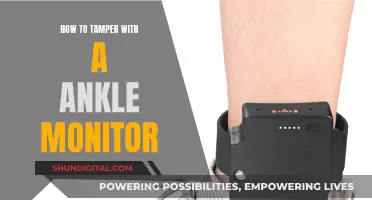
Liquid-crystal displays (LCDs) are a type of flat-panel display that uses liquid crystals to modulate light and display information. The technology is now ubiquitous, featuring in everything from digital clocks to televisions. But who invented the LCD?
The story of the LCD began in 1888 when Austrian botanist and chemist Friedrich Reinitzer discovered liquid crystals in cholesterol extracted from carrots. Reinitzer found that these liquid crystals had two melting points and the ability to generate colours. However, it wasn't until the 1960s that the first LCD was built.
In 1962, RCA researcher Richard Williams applied a voltage to a thin layer of liquid crystal material, generating stripe patterns. Then, in 1968, electrical engineer George Heilmeier and his team at RCA revealed the first LCD to the public. Heilmeier is often credited as the inventor of the LCD, as he was the first to demonstrate the technology. However, it was James Fergason who, in 1969, discovered the twisted nematic field effect, which would come to replace Heilmeier's dynamic scattering mode displays due to improvements in operating voltages and power consumption. Fergason's company, ILIXCO (now LXD Incorporated), began manufacturing TN-effect LCDs in 1971, and in 1972 produced the first modern LCD watch.
| Characteristics | Values |
|---|---|
| Inventor | George Heilmeier |
| Year of Invention | 1968 |
| Month of Invention | May |
| Inventor's Occupation | Electrical Engineer |
| Team Members | Louis Zanoni, Lucian Barton |
| Place of Invention | RCA David Sarnoff Research Center, Princeton, New Jersey |
| Organisation | Radio Corporation of America (RCA) |
| Country | USA |
| Technology Used | DSM (Dynamic Scattering Method) |
| Technology Replaced | Cathode Ray Tubes |
What You'll Learn
- The first LCD was revealed to the public in 1968 by George Heilmeier and his team of scientists
- The first LCD watch was produced in 1972 by James Fergason's company, ILIXCO
- The first LCD TV was released in 1982 by Seiko Epson
- In 1992, Hitachi developed In-Plane Switching (IPS) and Super IPS LCD devices
- In 1996, Samsung developed the optical patterning technique that enables multi-domain LCD

The first LCD was revealed to the public in 1968 by George Heilmeier and his team of scientists
In May 1968, electrical engineer George Heilmeier and his team of scientists at the Radio Corporation of America (RCA) revealed the first liquid crystal display (LCD) to the public. This was the culmination of years of research into the properties of liquid crystals, which were first discovered in 1888 by Austrian botanist and chemist Friedrich Reinitzer in cholesterol extracted from carrots.
Heilmeier's work built on that of fellow RCA researcher Richard Williams, who in 1962, had generated stripe patterns in a thin layer of liquid crystal material by applying a voltage. This effect, based on an electro-hydrodynamic instability, formed what is now called "Williams domains" inside the liquid crystal.
Heilmeier's LCD used what he called the dynamic scattering mode (DSM), which required an operating temperature of about 80°C. When a voltage was applied, the clear liquid crystal layer turned into a milky turbid state. This was a significant development because it only required relatively low voltages—something in the ten-volt range—to control the imagery on the display.
The dream of a flat television hanging like a picture on the wall was born.
Installing a 7-Inch TFT LCD Monitor: A Step-by-Step Guide
You may want to see also

The first LCD watch was produced in 1972 by James Fergason's company, ILIXCO
The history of the LCD monitor is a long and fascinating one, with many pioneers contributing to its development. One of the key figures in this story is James Fergason, who played a crucial role in bringing LCD technology to the world.
Fergason founded the International Liquid Xtal Company, or ILIXCO, in 1968 in Kent, Ohio. The company was one of the world's first Liquid Crystal Display manufacturers and was at the forefront of LCD innovation.
In 1971, ILIXCO produced LCDs based on twisted nematic (TN) technology, which offered significant improvements over the previous dynamic scattering mode (DSM) displays in terms of lower operating voltages and reduced power consumption. This advancement paved the way for the first LCD watch.
Indeed, in late 1972, just a year after ILIXCO's breakthrough, the world witnessed the introduction of the very first liquid crystal display (LCD) watch. This watch utilized a different type of LCD technology than what we are familiar with today. Known as Dynamic Scattering LCDs, these early displays were power-hungry and unstable, leading the market to swiftly move on to TN Field Effect displays.
The first LCD watch represented a significant milestone in the evolution of timepieces, marking the beginning of the digital watch era. While the technology has evolved and improved since then, with digital watches now being replaced by smartwatches, the introduction of the first LCD watch by James Fergason's company, ILIXCO, in 1972, remains a pivotal moment in the history of timekeeping.
Monitoring Data Usage: TDS Telecommunications Service Guide
You may want to see also

The first LCD TV was released in 1982 by Seiko Epson
Seiko Epson released the world's first television-equipped watch in June 1982. The TV Watch, as it was known, featured a 1.2-inch display with a tuner and headphones, and the ability to listen to FM radio. It also had an alarm, chronograph, calendar, and other functions. The display was an active-matrix liquid crystal panel that was based on a panel that had originally been developed for watches. The panel was modified to allow it to display moving images.
The TV Watch was equipped with what was, at the time, the world's smallest and lightest television. The television consumed less power than any previous TV; it could be used continuously for up to five hours with two AA-size dry-cell alkali batteries. Marketed under the Seiko brand, the TV Watch was put on the market in December 1982 and won the Nikkei Award for Superior Products & Services that year. It was also recognized by the 1984 Guinness Book of Records as the world's smallest television.
The Seiko TV Watch was an oddity in the form of a wrist-worn gadget, but the device captured the public's attention and was part of a larger fascination with wrist gadgets. Seiko was combining a relatively small LCD screen for the time-indicating operations with a separate system for the television screen. The time-telling system itself included the time, stopwatch, alarm, and calendar. To get the TV part of the TV watch to work, users needed to attach the six-pin connector to the top of the watch case, which itself is attached to the Walkman-style receiver unit. The receiver was either powered by two AA batteries or an AC adapter, which offered a lot more than the roughly five hours of promised television viewing time. The receiver was able to pick up both VHF and UHF television signal frequencies, as well as an FM band radio receiver.
The Seiko TV Watch was ahead of its time, predicting the modern-day desire to watch video content on smartphones.
Monitoring Furnace Usage: A Comprehensive Guide to Tracking Efficiency
You may want to see also

In 1992, Hitachi developed In-Plane Switching (IPS) and Super IPS LCD devices
In 1992, engineers at Hitachi developed In-Plane Switching (IPS) and Super IPS LCD devices. This was a significant milestone in the history of LCD technology, as it enabled the implementation of large-screen LCDs with acceptable visual performance for flat-panel computer monitors and television screens.
IPS is a screen technology for liquid-crystal displays (LCDs) that addresses the limitations of the twisted nematic (TN) field effect LCDs prevalent in the late 1980s. In IPS, the liquid crystal molecules are aligned horizontally to the screen and are reoriented by an applied electric field while remaining parallel to the surfaces. This results in improved colour reproduction and viewing angles compared to TN displays.
Hitachi's development of IPS technology involved solving various technical challenges. They worked on interconnecting the thin-film transistor array as a matrix and eliminating undesirable stray fields between pixels. Additionally, they optimised the shape of the electrodes in the Super IPS variant to further enhance the viewing angle dependence.
The adoption of IPS technology by Hitachi and other manufacturers marked a shift in the LCD industry. It paved the way for advancements in pixel density, light output, contrast ratio, response time, and backlight power efficiency. IPS panels became widely used in medical diagnostic displays, high-end graphics monitors, and various consumer devices, contributing to the evolution of flat-panel displays.
Asus Frameless Monitors: Speakers or No Speakers?
You may want to see also

In 1996, Samsung developed the optical patterning technique that enables multi-domain LCD
LCDs, or liquid-crystal displays, are flat-panel displays that use the light-modulating properties of liquid crystals combined with polarizers to display information. The development of LCD technology began in the 1960s, with the first liquid crystal display built in 1968 by George Heilmeier at the Radio Corporation of America (RCA). However, early LCDs required an operating temperature of about 80°C, and it wasn't until the 1970s that researchers were able to lower the operating temperature to room temperature.
In the mid-1990s, new technologies were developed to address the limitations of twisted nematic (TN) matrix LCDs, which were prevalent in the late 1980s and early 1990s. These included IPS and vertical alignment (VA) technologies, which offered improved viewing angles and color reproduction. Samsung's optical patterning technique for multi-domain LCDs built upon these advancements and played a crucial role in making LCDs a viable option for large-screen computer monitors and television screens.
The development of multi-domain LCDs by Samsung was part of the broader trend of increasing LCD size and performance throughout the 1990s. By the end of the decade, super-flat, high-resolution screens with diagonals of up to 40 inches were already available as prototypes. This push for larger and higher-quality displays led to the widespread adoption of LCD technology in computer monitors, laptops, and televisions.
Choosing the Right O-Ring Size for Delta Monitor Faucets
You may want to see also
Frequently asked questions
The liquid crystal display (LCD) monitor was invented by George Heilmeier and his team of scientists at the Radio Corporation of America (RCA) in 1968. Heilmeier was inducted into the National Inventors Hall of Fame and is credited with the invention of LCDs.
The LCD monitor was a turning point in the application of liquid crystals, which until then were only of scientific interest. The technology is now ubiquitous and can be seen on computers, alarm clocks, and the digital screens of microwaves.
An LCD monitor consists of two polarizers, two substrates (usually glass), electrodes, and the liquid crystal layer. Sometimes, there is also a color filter. As light passes through the first polarizer, it enters the liquid crystal layer. Depending on whether an electric field is present, the liquid crystal will behave differently, affecting the polarization of the passing light. If the light is polarized properly, it will pass through the color filter and the second polarizer, displaying a certain color.
Unlike CRT monitors, LCD monitors are flat, flexible, and do not require high voltage and a lot of power.







